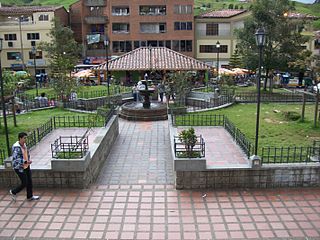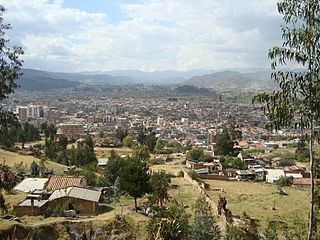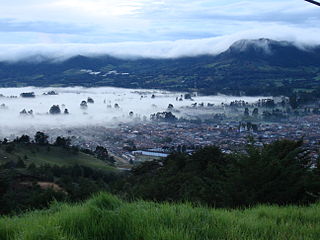
Medellín, officially the Municipality of Medellín, is the second-largest city in Colombia, after Bogotá, and the capital of the department of Antioquia. It is located in the Aburrá Valley, a central region of the Andes Mountains in South America. According to the National Administrative Department of Statistics, the city had an estimated population of 2,508,452 according to the 2018 census. With its surrounding area that includes nine other cities, the metropolitan area of Medellín is the second-largest urban agglomeration in Colombia in terms of population and economy, with more than 4 million people.

The Salt Cathedral of Zipaquirá is an underground Roman Catholic church built within the tunnels of a salt mine 200 metres (660 ft) underground in a halite mountain near the city of Zipaquirá, in Cundinamarca, Colombia. It is a tourist destination and place of pilgrimage in the country. The temple at the bottom has three sections, representing the birth, life, and death of Jesus. The icons, ornaments and architectural details are hand carved in the halite rock. Some marble sculptures are included. The cathedral is considered one of the most notable achievements of Colombian architecture, being described as a "Jewel of Modern Architecture". The cathedral represents a valuable cultural, environmental and religious patrimony for the Colombian people.

Amalfi is town and municipality of the Colombian Andes, northern part of the Central Mountain Range in the Antioquia Department and part of the subregion of Northeastern Antioquia. The territory of Amalfi is bordered by the municipalities of Anorí and Segovia at its north; Segovia, Remedios and Vegachí at the east; Vegachí, Yalí, Yolombó and Gómez Plata at the south and Anorí and Guadalupe at the west. The town is served by Amalfi Airport.

Santa Fe de Antioquia is a municipality in the Antioquia Department, Colombia. The city is located approximately 58 kilometres (36 mi) north of Medellín, the department capital. It has a population of approximately 23,000 inhabitants.

Don Matías is a municipality in Antioquia Department, Colombia. Part of the subregion of Northern Antioquia. Bordered to the north by the municipality of Santa Rosa de Osos, to the east by the municipalities of Santa Rosa de Osos and Santo Domingo, to the south by the municipality of Barbosa, and to the west by the municipality of San Pedro de los Milagros.

Jardín, often mistakingly referred to as El Jardín, is a town and municipality in the southwest region of Antioquia, Colombia. It is bounded by the Andes, Jericó, and Támesis municipalities to the north and the Caldas department to the south. The municipality is located between the San Juan river, which is called Docató by the natives, and a branch of the Western Cordillera. Jardín is identified by its preserved colonial architecture, lush vegetation, and abundant rivers and streams.

Santa Rosa de Osos is a middle city and municipality of Colombia located in the northern of the department of Antioquia. Bounded on the north with the municipalities of Yarumal and Angostura, on the east with Guadalupe and Carolina del Principe, on the south with the municipalities of Donmatías, San Pedro de los Milagros and Entrerríos, and on the west with Belmira and San José de la Montaña.

Sonsón is a municipality in the Colombian department of Antioquia. Sonsón is located in Eastern Antioquia. It is one of the seats of the Roman Catholic Diocese of Sonsón–Rionegro. Sonsón celebrates "Las Fiestas Del Maíz"- during the month of August, being the most traditional, historical and representative festival in western Colombia.

Sopetrán is a municipality of Colombia, located in the subregion west of the state of Antioquia. It is bounded to the north by the municipality of Olaya, to the east by the municipality of Belmira, to the south by the municipalities of San Jerónimo and Ebéjico, and to the west by the municipality of Santa Fe de Antioquia. It is 59 kilometers from the city of Medellin, the state capital of Antioquia. The municipality of Sopetrán has an area of 223 square kilometers.

Rionegro is a city and municipality in Antioquia Department, Colombia, located in the subregion of Eastern Antioquia. The official name of the city is "Ciudad Santiago de Arma de Rionegro". Rio Negro means "Black River" in Spanish, as the city received its name after a river that looks black because of the shadows cast by trees. The river traverses the city and it is the most prominent geographical feature of the municipality. Rionegro is also sometimes called the Cuna de la democracia as it was one of the most important cities during the era of the Colombia's struggle for independence and the 1863 constitution was written in the city.

The University of Antioquia, also called UdeA, is a public, departmental, coeducational, research university located primarily in the city of Medellín, Antioquia, Colombia, with regional campuses in Amalfi, Andes, Caucasia, Carmen de Viboral, Envigado, Puerto Berrío, Santa Fe de Antioquia, Segovia, Sonsón, Turbo and Yarumal. It is the oldest departmental university in Colombia, founded in 1803 by a Royal Decree issued by King Charles IV of Spain under the name Franciscan College. It is considered one of Colombia's best universities, receiving a high quality accreditation from the Ministry of Education for 9 years. Along with the University of the Andes, the two universities hold the second longest term, behind the National University of Colombia. UdeA and the Tecnológico de Antioquia have the largest number of seats in the department of Antioquia. It is also renowned for its prestigious Faculty of Medicine, which is acknowledged as one of the best medical schools in Colombia.

Sogamoso is a city in the department of Boyacá of Colombia. It is the capital of the Sugamuxi Province, named after the original Sugamuxi. Sogamoso is nicknamed "City of the Sun", based on the original Muisca tradition of pilgrimage and adoring their Sun god Sué at the Sun Temple. The city is located at an altitude of 2,569 metres (8,428 ft) on the Altiplano Cundiboyacense in the Eastern Ranges of the Colombian Andes.

Mompox or Mompós, officially Santa Cruz de Mompox, is a town and municipality in northern Colombia, in the Bolívar Department. The town initially grew from its proximity to the Magdalena river and has preserved much of its colonial character. It also played an important role in the liberation of South America from Spain. Today, Mompox depends upon tourism, fishing, and some commerce generated by the local cattle raising. It has about 30,000 inhabitants, and is adjacent to the municipalities of Pinillos and San Fernando. The historic center of Mompox was made a UNESCO World Heritage Site in 1995, owing to its preserved colonial architecture and mixture of architectural styles.

The Caribbean region of Colombia or Caribbean coast region is in the north of Colombia and is mainly composed of 8 departments located contiguous to the Caribbean. The area covers a total land area of 132,288 km2 (51,077 sq mi), including the Archipelago of San Andrés, Providencia and Santa Catalina in the Caribbean Sea and corresponding to approximately 1/10 of the total territory of Colombia. The Caribbean region of Colombia is home to approximately 9 million residents according to the Colombian Census 2005.

Pedro de Heredia was a Spanish conquistador, founder of the city of Cartagena de Indias and explorer of the northern coast and the interior of present-day Colombia.

The contribution of travel and tourism to GDP was US$5,880.3bn in 2016. Tourism generated 556,135 jobs in 2016. Foreign tourist visits were predicted to have risen from 0.6 million in 2007 to 4 million in 2017. Responsible tourism became a peremptory need for Colombia because it minimizes negative social, economic and environmental impacts and makes positive contributions to the conservation of natural and cultural heritage.

La Ceja del Tambo, often called simply La Ceja, is a town and municipality in the Antioquia Department of Colombia. It is part of the subregion of Eastern Antioquia. La Ceja borders the Rionegro and Carmen de Viboral municipalities to the north, La Unión to the east, and Montebello and Retiro to the west. It is located approximately 41 kilometers from Medellín, one of the main cities of the department.

San Andrés is a town and municipality in Antioquia Department, Colombia. Part of the subregion of Northern Antioquia.

The Villa de Santa Cruz de Mompox was founded by Don Juan Quintero de Heredia, Adelantado of the Gobernation of Cartagena and brother of the founder of that city, Pedro de Heredia, on May 3, 1537, after fighting battles against the Kimbay tribe and defeating the Chieftain Mompoj.


























